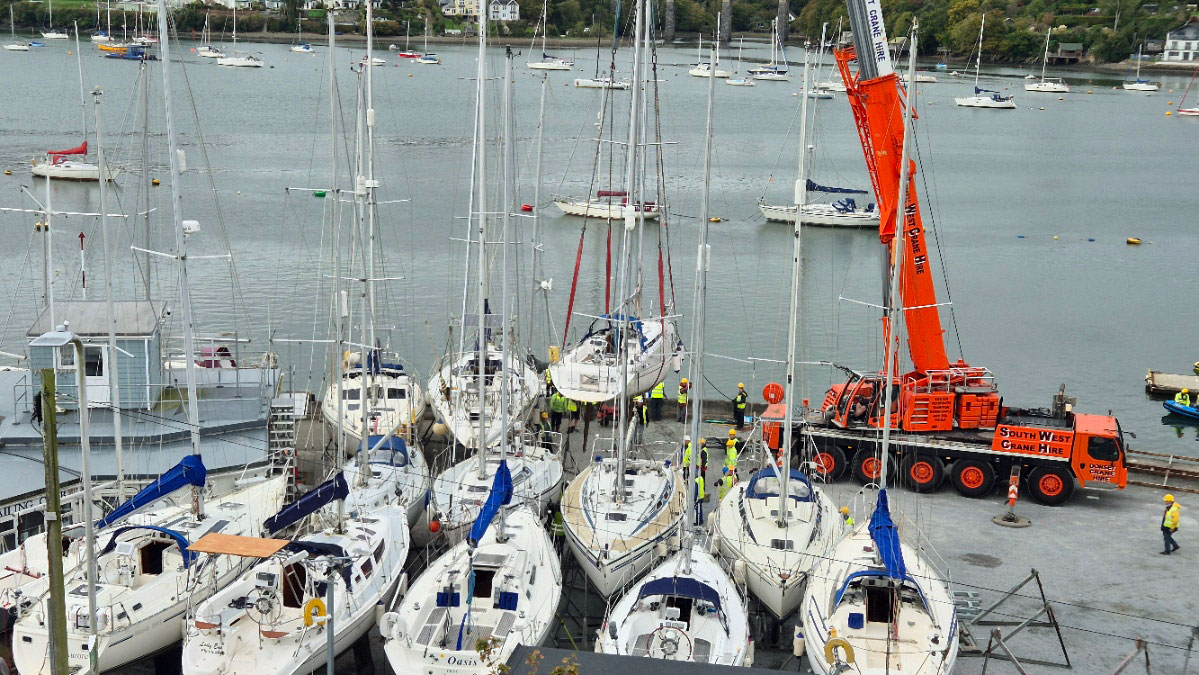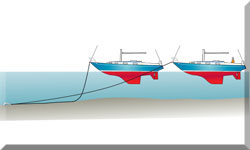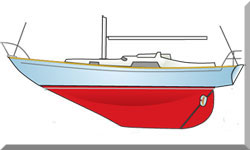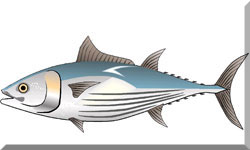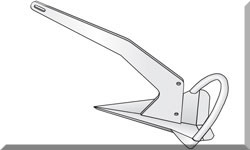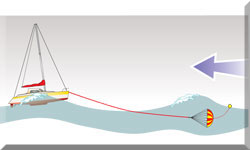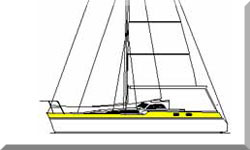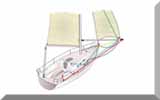- Home
- Bluewater Sailing
- Sailboat Hauling Out and Laying-Up
Preparing Your Sailboat for Storage: The Guide to Hauling Out and Laying-Up
In a Nutshell...
Laying up your sailboat for the off-season is much more than a routine chore; it's vital insurance against cold, pests, and corrosion. The key is thoroughness. Always service the engine and remove sails while the boat is still afloat. Supervise the lift-out carefully, ensuring strops are placed correctly and the hull is secure on its stands. Above all, clean, dry, and ventilate the entire boat. Get this preparation done right now, and you'll trade costly spring repairs for a seamless return to the water.
Table of Contents
The Annual Chore: When & Why to Haul Out
Unless you’re lucky enough to sail year-round, you’ll face the annual job of hauling your boat out and laying her up ashore. Don't skimp on this; it’s about protecting your boat from the worst that the off-season weather—or pests—can throw at her.
For those of us in higher latitudes, the decision is straightforward: haul out in autumn to escape the inevitable, damaging freeze-thaw cycles of winter.
In tropical regions, the threat is far more dramatic: hurricanes, cyclones, or typhoons. These storms hit during summer and autumn, so a prudent boat owner should be planning their haul-out in late spring, well ahead of the official season.
Regardless of the climate, the moment of maximum stress is the haul-out itself. But first, a couple of jobs are best handled while she’s still bobbing comfortably.
Before She Comes Ashore: What to Do While Still Afloat
Certain tasks are far simpler and more effective when the boat’s still in the water, giving you easy access to the deck and engine.
1. Getting the Sails Off
The time to get the sails down, flaked, and bagged is now. It's infinitely easier with the boat laying head-to-wind at her mooring.
Seriously, never leave a roller-furling headsail in place over the winter. They have a terrible habit of unfurling in a strong gale, thrashing themselves to rags, and potentially damaging your rigging or the boat alongside yours.
2. Changing the Engine Oil
Throughout the season, moisture has condensed on the internal engine surfaces, mixing with the oil. Left over winter, this acidic cocktail eats away at bearings and other vital components.
The oil should be warm and thin when you drain it to ensure a complete evacuation, making the time just before the lift-out perfect. Always change the oil filters as well.
The Lift: Hauling Out Safely & Securely
This is the moment that always gets the pulse rate up—it’s where mistakes can cost thousands.
Positioning the Strops
Lifting strops can do serious damage to underwater gear if they’re not positioned correctly. The rudder, the propeller and shaft, and the thru-hull log impeller are all vulnerable.
I always use blue masking tape on the topsides to show the crane or hoist operator exactly where to place the strops, ideally lining up with internal bulkheads. Make sure the yard staff use protection—a piece of old carpet or cardboard works well—between the hull and the strop itself.
Cranes, Hoists & the Squeeze Factor
| Lifting Method | Primary Risk | Mitigation | Ideal For |
|---|---|---|---|
| Crane & Single Hook | Compressive loads on hull topsides (The Squeeze). Risk to stanchions & masthead instruments. | Use long strops. Route strops inside guard wires. Use a spreader bar if possible. | Tight quarters, quick lifts. |
| Travel Hoist | None (eliminates crushing loads). | Ensure correct strop placement to avoid underwater gear. | Wide spread yards, large vessels. |
| Forklift (Wiggins 'Marina Bull') | Less of a risk for sailboats, but requires careful slinging. | No risk to masthead instruments. Excellent in breezy conditions. | Dry stack operations, smaller to medium sailboats. |
If you're using a crane, strops hung from a single hook will put a big pinching load on the hull topsides. Beamy boats and short strops make this worse. Your stanchions and guard wires are at risk, so you may need to route the strops inside the guard wires to protect them.
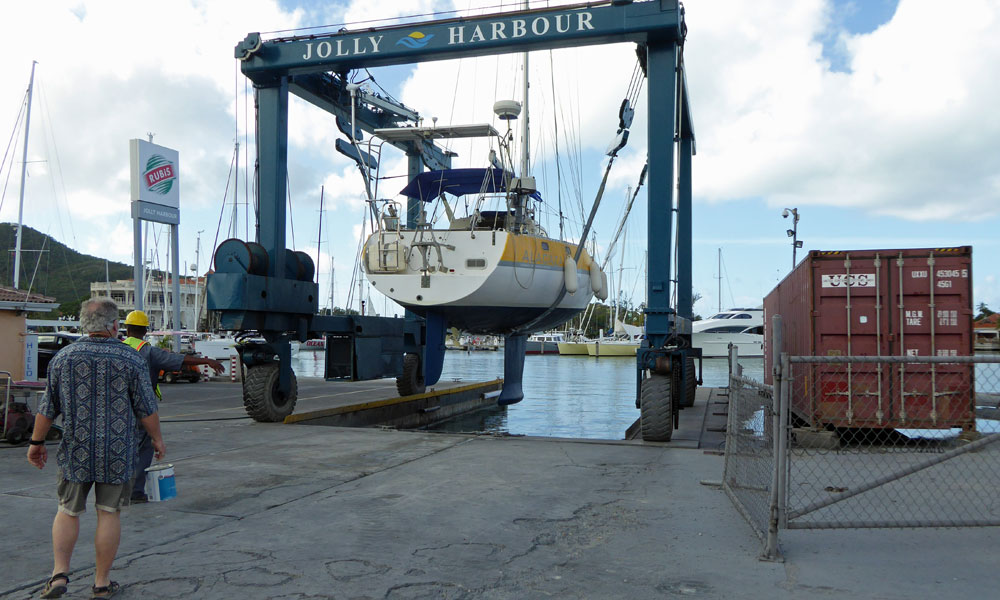 An anxious owner looks on...
An anxious owner looks on...A travel hoist, used by most larger yards, completely eliminates these crushing loads due to the wider spread of the strops. Some yards use purpose-built forklifts, like the Wiggins ‘Marina Bull’, which sling the boat securely. Forklifts are excellent in windy conditions and pose no risk to masthead instruments.
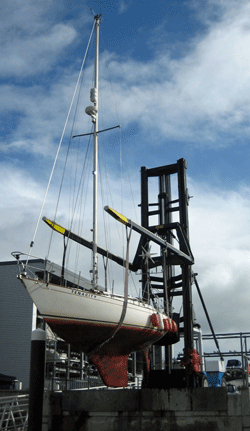 A Wiggins ‘Marina Bull’ forklift in action
A Wiggins ‘Marina Bull’ forklift in actionTripod Jackstands or a Boat Cradle?
Security ashore is paramount. For a 40-footer, four tripod stands per side and one under the bow is a minimum requirement.
- Foundation First: Unless you’re on a concrete hardstanding, every leg of every tripod must sit on a piece of plywood or planking. This stops the stand from sinking into soft ground during heavy rain.
- Prevent Movement: Chain each tripod to its opposite number across the boat—or even better, use a web of welded rebar tie-rods to lock everything in place. This meticulous preparation and attention to detail when the boat is laid-up is the same ethos of preparedness and safety required for the open sea, an integral part of The Ultimate Blue Water Sailing Guide: Preparation & Seamanship for the Ocean.
- Level Up: Use a spirit level to ensure the boat is sitting level, allowing any rainwater to run out properly through the scuppers and cockpit drains.
For ultimate security against winter gales, nothing beats a custom-fitted cradle, particularly one that can be chained to ground anchors. That’s real peace of mind.
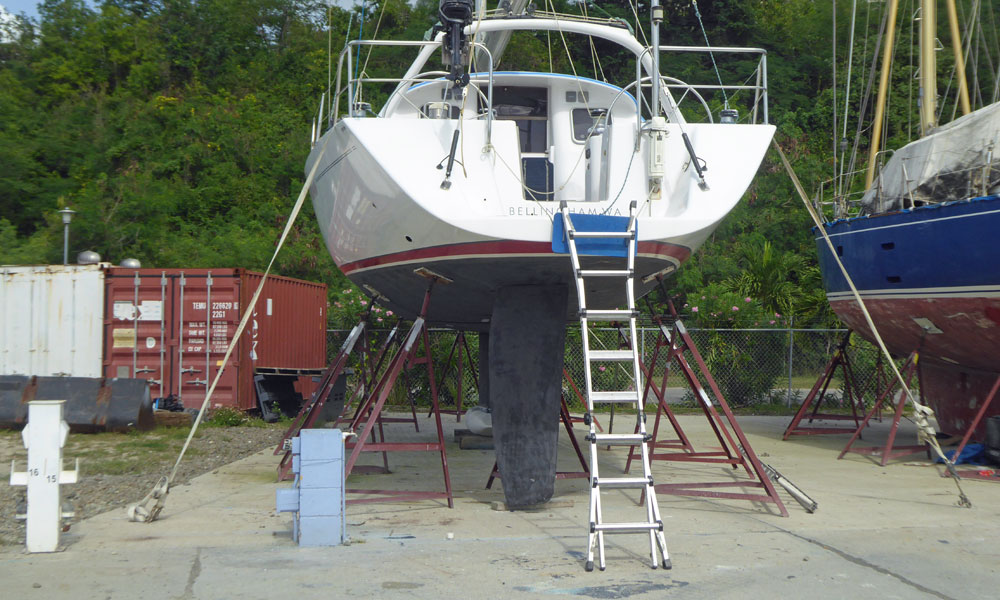 A sailboat stored on tripod stands and strapped down to ground anchors for the Caribbean hurricane season
A sailboat stored on tripod stands and strapped down to ground anchors for the Caribbean hurricane season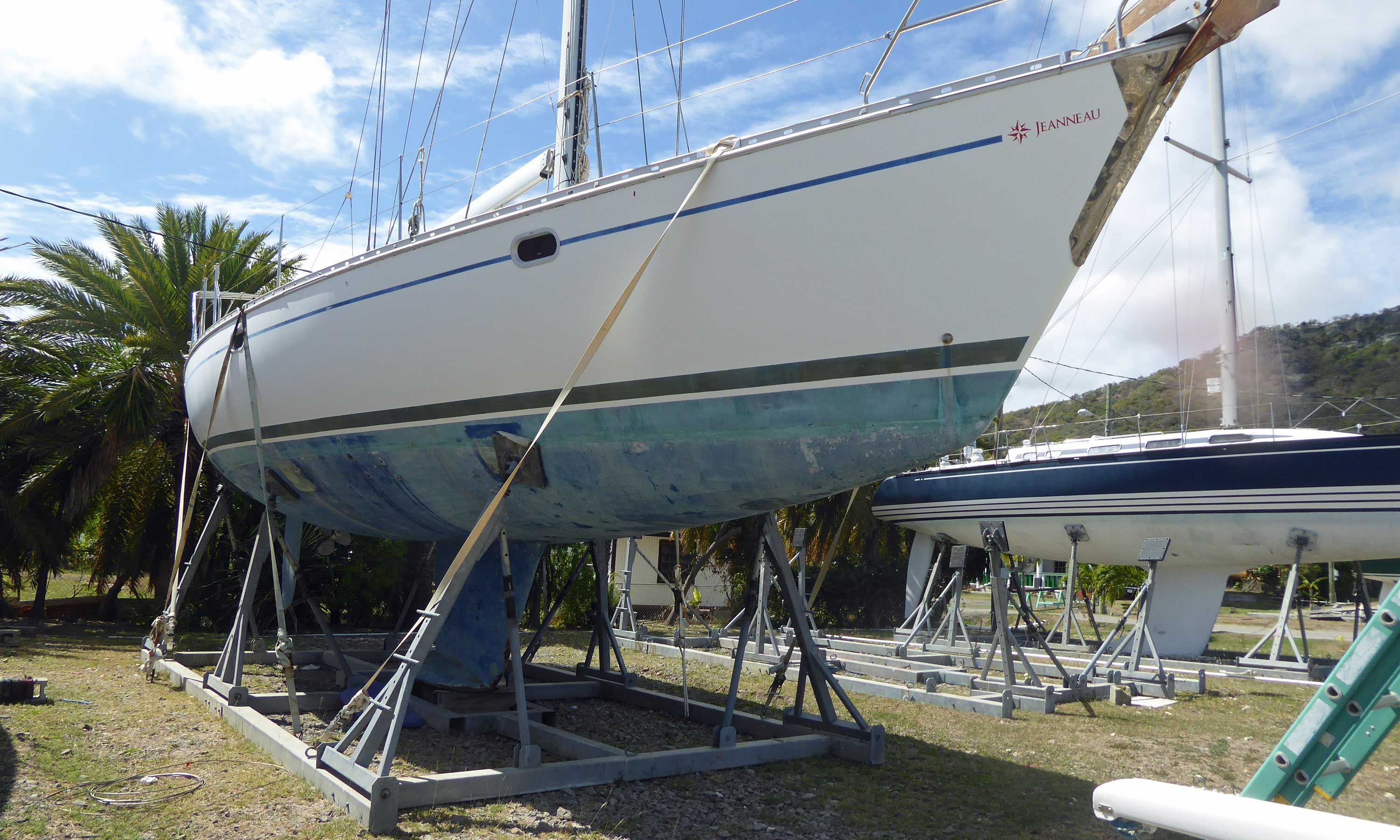 For ultimate security, nothing beats a custom-fitted cradle.
For ultimate security, nothing beats a custom-fitted cradle.Now the Real Work Starts: Protecting Your Boat
High winds, torrential rain, freezing temperatures, and tropical heat will all conspire to damage your vessel. Below decks, condensation, corrosion, and mildew are just as destructive. Here’s how you fight back:
Engine & Exhaust System Care
Neglecting the engine over winter virtually guarantees a painful repair bill in the spring.
1. Exhaust Waterlock: These devices catch water to prevent it running back into the engine. They usually have a drain plug. Drain and disconnect the exhaust waterlock! If you don’t, trapped water can freeze and split the unit. Even in warm climates, disconnecting the engine-side hose is crucial, as residual water will evaporate and settle as vapour inside the engine, causing havoc with the valves.
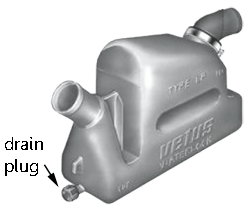 A Vetus Waterlock
A Vetus Waterlock2. Fuel System: The notorious 'cladisporium resinae' or diesel bug needs water to thrive.
- Fill the Tank: Top up your fuel tank completely. This eliminates the air space where condensation forms.
- Biocide Treatment: Dose the fuel with a biocide to kill any existing bugs.
3. Outboard Motor Lay-up: To avoid the dread of a non-starting outboard, you need ‘fogging’ oil.
- Run the outboard at idle with the fuel supply turned off.
- Just as the engine starts to cough and die, spray the fogging oil directly into the air intake until it stops. This purges the petrol (gas) from the system and coats all internal parts with a protective, anti-corrosion film.
Running Gear & Thru-Hull Fittings
- Seacocks: The dreaded seized seacock! Lubrication is key. With one person inside operating the seacock and another outside with a can of non-petroleum based aerosol penetrating lubricant, open the fitting and spray the oil up through it. Work the seacock open and closed several times until it moves freely.
- Cutless Bearing: Check the prop shaft for excessive movement in the bearing. If you feel anything more than a tiny amount of play, it’s time for a replacement.
- Anodes: Inspect all sacrificial anodes now. Replace any that are more than 50% eroded. If they haven’t eroded much, find out why—check all connections and contact surfaces.
Pro Tip: If your prop shaft is supported by a P-bracket, fit a shaft anode ahead of it. Position the shaft anode at least 75mm (3 inches) or so forward of the bearing to allow a clear flow of water for lubrication. - Thru-Hulls for Ventilation: I always remove the thru-hull log impeller and depth sounder transducer. This not only improves ventilation but ensures any rainwater that gets below decks will drain out. If you're concerned about pests, cover the apertures with a fine, rot-proof mesh and tape it down.
Standing Rigging Inspection & Mast Care
The care of your standing rigging is crucial for offshore safety. It requires professional attention, even if you leave the mast stepped.
- Lubricate Turnbuckles & Release Tension: Loosen the bottle screws on your shrouds and stays by a turn or two. This relieves undue stress on the rigging and hull fittings over the winter. Clean the threads thoroughly and apply a marine-grade grease or lubricant to prevent them from seizing.
- Visual Inspection: If the mast is staying up, you need to inspect every swage fitting, terminal, and tang you can reach. Look for hairline cracks, rust 'bleeding' from the fitting, or any broken strands of wire near the terminal—these are the major warning signs. A comprehensive check is crucial, as detailed in our guide on Inspecting & Maintaining Your Standing Rigging.
- Unstep and Overhaul: If you unstep the mast (advised every four to five years), it's your only real chance to thoroughly check the masthead instruments, wiring connections, sheaves, and the VHF aerial connection. Support the mast properly to prevent bending and store it horizontally off the ground.
Interior Systems & Damp Control
Moisture is the silent killer, promoting mould and corrosion below decks.
- Water Tanks & Plumbing: Standing water stagnates and will freeze. Drain and dry all water tanks and run the pumps until the lines are clear. In freezing environments, you must introduce non-toxic propylene glycol antifreeze into all plumbing, including the heads, water heater (calorifier), and shower sump, pumping it through until it emerges at every outlet.
- Ventilation is Non-Negotiable: Condensation is your sworn enemy. Leave all bunk cushions propped up, locker doors ajar, and floorboards (soles) lifted slightly. For constant airflow, ensure you have robust, all-weather vents fitted to your hatches.
- Batteries & Charging: Your batteries need attention. Either ensure they are fully charged and disconnected, or leave the bank connected to a solar or wind-powered trickle charger. If you maintain the charge this way, leave a low-current device switched on, as batteries prefer a small load.
Caution: Don't use a GPS set for this, as prolonged use may damage the screen.
- Watermaker: Always consult the manufacturer's instructions. If your watermaker is a reverse osmosis type, it will need to be biocided to prevent membrane failure.
Vermin Control: Keeping Unwanted Guests Ashore
It's an unpleasant reality: your warm, dry boat looks like a five-star resort to mice, rats, and insects. They can cause catastrophic damage, chewing through expensive upholstery and, most critically, electrical wiring and plastic plumbing.
- Remove All Food: You must clear every single crumb of food and drink. This includes spices, dried goods, and pet food. A clean galley is your first defence. Wipe down surfaces and leave the fridge/freezer doors propped open.
- Seal Entry Points: Rodents can squeeze through tiny gaps. Temporarily stuff stainless steel wool or bronze wool into all through-deck wiring openings, exhaust ports, and any holes where lines enter the hull.
- Traps and Repellents: Use traps rather than poison. Poison can lead to a dead, rotting animal in an inaccessible part of your boat, creating an impossible-to-remove odour. Many sailors find that placing blocks of Irish Spring soap or cotton wool balls soaked in peppermint oil in lockers and under cushions often deters mice effectively.
Rigging, Spars & Canvas
These are expensive assets that deserve careful storage.
- Running Rigging: All running rigging—mainsheet tackle, kicker assembly, sheets, control lines—should be removed. Soak them in a mild detergent, rinse thoroughly in fresh water, and let them dry naturally before storing them below or at home.
- Halyards: Tie messenger lines to the ends of all your halyards, remove them, and clean them as above. If you choose to leave them up, tie them off well clear of the mast to prevent the constant slapping from damaging the mast anodising.
- Spars: At a minimum, lash the aft end of the boom down on deck, but removing it completely and laying it on the side-deck or coach-roof is better.
- Canvas: Remove all canvas covers—sprayhoods, dodgers (weather cloths), sailcovers, cockpit cushions, etc. Wash them in warm soapy water, rinse, and store them until the next launch.
Anchor & Chain
Drop the anchor and chain onto a clean surface (an old pallet works well), rinse it thoroughly in fresh water, and allow it to dry. Clean the anchor locker before re-stowing the gear. This is also a good opportunity to check the galvanising and the chain’s overall condition.
Five Costly Lay-Up Mistakes to Avoid
Even the most meticulous sailors can overlook small details that lead to expensive, time-consuming repairs come spring. Avoid these five common and costly errors:
- Ignoring the Bilge Pump Discharge Line: The bilge pump itself can handle a freeze, but water trapped in the discharge hose that exits the hull can freeze and expand, cracking the hose. If this line breaks below the waterline during re-launch, the result is a slow but steady sinking, as the pump line becomes a siphon. Always drain and disconnect the line.
- Leaving Hull Growth to 'Set': Failing to pressure wash the hull immediately after it comes out of the water is a huge mistake. Biofouling (slime, barnacles, weed) hardens almost instantly in air. Waiting even 24 hours can turn a 30-minute wash into a full, difficult scraping job requiring specialised chemicals or sanding.
- Trapping Moisture with a Tight Cover: A full-boat cover, especially shrink-wrap, is only effective if it's perfectly installed with a proper framework and vents. A loose or tightly-sealed cover without adequate ventilation will trap humidity, leading to a prolific, expensive explosion of mildew on all interior soft furnishings and wood. Ensure constant airflow.
- Forgetting to Seal the Mast Partners: For boats where the mast passes through the deck (deck-stepped), water inevitably gets in through the mast partners. Over winter, this continuous leak is a primary cause of rot in the mast step beam below. A temporary, tight seal of plastic or tape around the mast boot is cheap insurance against a structural problem.
- Not Labelling Running Rigging: It's tempting to coil and throw your clean running rigging into a storage bag. Next season, figuring out which line is the reefing line, which is the spare halyard, and which is the pole lift on a complex boat can take hours. Label every line with durable tags before removal.
The Turnaround: A Pre-Launch Commissioning Checklist
Lay-up isn't the final step; it’s the middle of the annual cycle. The mark of a true expert is planning for the re-commissioning now. Use this abbreviated list when it’s time to get the season started.
| System/Area | Re-Commissioning Action & Checks |
|---|---|
| Engine | Refill exhaust waterlock & reconnect hose. Bleed fuel system (if necessary). Change transmission oil. Install new impeller. Start engine and run for 5 minutes before launching. |
| Rigging | Re-install running rigging (use those labels!). Tune standing rigging to specification. Check all turnbuckle lock nuts are secure. |
| Thru-Hulls | Open all seacocks and confirm they move freely. Re-install log impeller and transducers (and remember their safety clips). |
| Plumbing | Flush non-toxic antifreeze out of all plumbing systems. Flush and sterilise water tanks (e.g., with mild bleach solution). Refill water heater/calorifier before switching on the element. |
| Batteries | Reconnect fully charged batteries. Check terminals are clean, tight, and greased with dielectric grease. |
| Launch Prep | Ensure the garboard drain plug is secured (if fitted). Check the bilge is completely dry. |
Summing Up
Laying up a sailboat is a detailed, methodical process, not a rush job. The effort you put in now, from changing that acidic engine oil to meticulously lubricating every seacock and setting up your vermin control, will pay dividends when spring arrives. This annual preparation is a prerequisite for a seaworthy vessel; it’s an investment in the health of your boat and ensures that your next season starts with an easy launch, not a frantic repair spree. Don't just tick the boxes on the list; approach each task with the care of a skipper preparing for an ocean passage.
This article was written by Dick McClary, RYA Yachtmaster and author of the RYA publications 'Offshore Sailing' and 'Fishing Afloat', member of The Yachting Journalists Association (YJA), and erstwhile member of the Ocean Cruising Club (OCC).
Frequently Asked Questions
1. How can I prevent ‘the squeeze’ damage during a crane haul-out?
1. How can I prevent ‘the squeeze’ damage during a crane haul-out?
The best way is to ensure the yard uses a spreader bar with the crane, which eliminates the pinching pressure on your hull topsides. If that’s not an option, insist on longer lifting strops and make sure they’re placed precisely on internal bulkheads. Crucially, route the strops inside your guard wires, particularly the stern one, to protect stanchions.
2. Is it better to leave my boat afloat or haul her out for the winter?
2. Is it better to leave my boat afloat or haul her out for the winter?
For northern latitudes prone to freezing, hauling out and laying up ashore is the safest bet to avoid freeze-thaw damage to your hull, engine, and plumbing. In hurricane or cyclone zones, getting her ashore is absolutely non-negotiable. Only in temperate regions with no risk of frost or storm-force winds can you safely consider leaving her afloat, and even then, you must take extra precautions with mooring lines and fenders.
3. What is 'fogging' an engine and why is it important for lay-up?
3. What is 'fogging' an engine and why is it important for lay-up?
Fogging is the process of coating the internal combustion surfaces (like cylinder walls and pistons) of an engine with a protective oil. It’s vital because a dormant engine's oil drains away, leaving the metal parts exposed to moisture and corrosion over the lay-up period. Spraying fogging oil into the air intake just as the engine runs out of fuel creates a protective barrier, preventing rust and ensuring the engine is ready to fire up again next season.
4. What should I do with my marine batteries over the winter lay-up?
4. What should I do with my marine batteries over the winter lay-up?
You have two main options: 1) Remove them entirely, store them in a cool, dry place, and keep them on a trickle charger to maintain their full charge. 2) Leave them aboard, fully charged, and connected to a small solar or wind-powered charging device. A fully charged battery is far less likely to freeze, and having a small draw (not GPS) is better for battery health than no draw at all. Either way, disconnect non-essential electrics.
5. Why do I need to fill my fuel tank completely if I'm not going anywhere?
5. Why do I need to fill my fuel tank completely if I'm not going anywhere?
The primary reason is to eliminate air space inside the tank. That air space is where condensation forms as temperatures fluctuate. Since the notorious diesel bug (cladisporium resinae) needs water to thrive and multiply, eliminating the water dramatically reduces the risk of fungal growth, which can clog filters and cause serious engine problems once you're back out sailing.
6. How do I protect the interior of my boat from vermin during storage?
6. How do I protect the interior of my boat from vermin during storage?
The best defence is cleanliness and exclusion. Remove all food and beverages, no matter how small. Secondly, seal entry points by stuffing steel wool into openings like exhaust ports and wire conduits. Finally, use traps or natural repellents like peppermint oil or Irish Spring soap blocks placed strategically in lockers and bilges.
7. Why must I check the bilge pump line after haul-out?
7. Why must I check the bilge pump line after haul-out?
Failing to drain the bilge pump discharge hose is one of the most common and costly mistakes. Water trapped in the line that runs outside the boat can freeze, crack the hose, and, if the break is below the waterline, cause the boat to sink when relaunched because the line turns into a siphon.
Recent Articles
-
Optimising Your 12-Volt Boat Fridge for Offshore Sailing & Efficiency
Dec 01, 25 11:05 AM
Master your 12-Volt Boat Fridge system. A guide for experienced sailors covering mechanics, installation, troubleshooting, and advanced electrical efficiency on extended voyages. -
Jonmeri 40: Cruising Specs, Performance Ratios & Review
Nov 30, 25 09:08 AM
An in-depth, expert review of the Jonmeri 40 sailboat. Analyse design philosophy, D/L & CSF ratios, cruising suitability, and common ownership concerns for this Finnish-built, high-performance ocean c… -
Alajuela 48: Review, Specs, & Performance Ratios for Offshore Cruisers
Nov 29, 25 12:46 PM
Detailed analysis of the Alajuela 48 full-keel cruiser, including designer Robert Perry's philosophy, comprehensive specifications, key design ratios (SA/D, D/L, CSF), and suitability for experienced…
